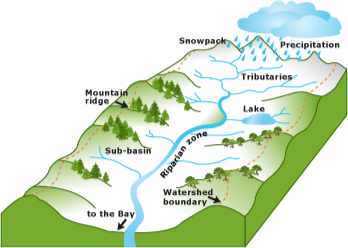Barely 2.8% of all water on Earth is freshwater . Most of it is found in glaciers and pack ice (77%) and in groundwater (22%).the rest, only 1%, forms the watercourses that irrigate valleys and plains. Fresh water or freshwater is any naturally occurring liquid/solid water containing low concentrations of dissolved salts and other total dissolved solids. As it flows down from mountaintops to the ocean, freshwater feeds glaciers, lakes , and rivers . the water evaporates and forms clouds, precipitation from which feeds watercourses. For millions of years, this vast water cycle has created landscapes by carving out valleys, eroding mountains, and changing shorelines . It plays an essential role in the redistribution of water around the planet.
Watersheds
A watershed is a region where all water—precipitation, runoff , and groundwater—flows toward a common body of water. A single watershed may contain a number of smaller watersheds.

THE LARGEST RIVERS
RIVER, CONTINENT, LENGTH, AREA OF WATERSHED
Nile, Africa, 6,670 km, 2,870,000 km2
Amazon, South America, 6,570 km, 6,915,000 km2
Yangzi, Jiang Asia 6,300 km, 1,855,000 km2
Mississippi–Missouri, North America, 5,970 km, 2,980,000 km2
Jenissei–Angara, Asia, 5,870 km, 2,580,000 km2
Ob–Irtych, Asia, 5,410 km, 2,990,000 km2
Paranà–Rio de la Plata, South America, 4,880 km, 3,100,000 km2
Congo, Africa, 4,630 km, 3,680,000 km2
Amur, Asia, 4,440 km, 1,855,000 km2
Lena, Asia, 4,268 km, 2,490,000 km2
Mackenzie, North America, 4,241 km, 1,790,000 km2
Niger, Africa, 4,184 km, 2,090,000 km2
Mekong, Asia, 4,023 km, 810,000 km2
Volga, Europe, 3,687 km, 1,380,000 km2
Murray–Darling, Oceania, 3,370 km, 1,057,000 km2

Watercourses
Springs, rivers, and lakes form a network with a hierarchy: each flows into a large watercourse, and all watercourses finally flow into the sea. A river such as the Amazon, for example, is fed by 15,000 tributaries.
Rainwater seeps into the ground and rises to the surface in the form of a spring, then flows down hills and mountains. Sometimes fed by meltwater from glaciers, the stream becomes a torrent ; then, fed by more springs, it becomes young river that continues to flow down the mountain, following sleep slopes and forming waterfalls . The river carves out deep gorges, and then broadens. Fed by tributaries, it becomes a large river. As it grows wider, the river forms meanders. Many rivers form deltas at their mouths, and finally flow into the sea. Evaporation of water from the oceans forms clouds, and the water cycle starts over.

